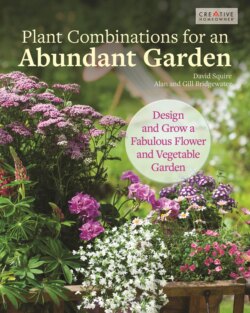Читать книгу Plant Combinations for an Abundant Garden - A. & G. Bridgewater - Страница 10
На сайте Литреса книга снята с продажи.
GATHERING INSPIRATION
ОглавлениеIn much the same way as poets and artists draw inspiration from their interests and passions – romantic love, the glories of nature, the wonders of technology, travel – so the garden designer needs to draw inspiration from his or her experiences and passions. Whatever your interests may be – trees, roses, water, travel, eating in the garden, watching your children at play – your best starting point is to draw inspiration from the things that give you pleasure.
Where do I start?
LOOKING AND COLLECTING
Note the large, permanent objects and items that you have to live with, such as the house, boundary walls and large trees, and then look around you at the things you have collected. For example, you might have a collection of nautical bits like anchors, glass floats and chains, old street lamps, old farm items, special plants or perhaps even your holiday photographs to inspire you.
A collection of bamboos could well be inspirational.
Favorite plants can also provide great inspiration.
Try found objects such as Victorian street lamps.
Postcards of beautiful gardens will give you something to aim for.
Books, magazines and television programs
Once you have come up with the bare bones of a scheme, follow through your research by looking through books and magazines, and by watching television. It is a good idea to make a collection of the ideas that you would like to include in your design – colors, plants, materials, structures, furniture, in fact anything and everything that strikes your fancy.
Keep a scrapbook. Save photographs from magazines and catalogs that show things like grand houses, flowers or sculpture.
Garden centers and nurseries
Garden centers and nurseries are great places for searching out ideas. Arm yourself with a digital camera, paper and pencil, and take note of everything that looks interesting. Gather a body of data to flesh out and back up your ideas – names of plants, colors, growing habits and so on. If you have in mind to go for a theme, say a Japanese garden, search out plants, materials and products that you know to be variously useful, traditional or characteristic.
Wander around the garden center or nursery keeping an eye open for anything that might spark an idea, such as unusual containers.
As you walk slowly around the various displays, take photographs of plants, products and features that you think might fit well into your scheme.
Visiting gardens
If you have a friend who has created a beautiful garden, when you next visit ask them to tell you about how they got started and how the design has evolved.
It is also a good idea to visit world-renowned gardens that are open to the public. In the US, for example, there are the Brooklyn Botanic Garden, Missouri Botanical Garden, Atlanta Botanical Garden, Denver Botanic Gardens and Leach Botanical Garden, to name a few.
A fine example of a traditional English pergola, with solid square-section brick columns topped off with oak beams.
A well-planted border can be a joy to the eye – so stunning that you might want to copy it in every detail.
Sometimes a particular arrangement of plants and structures, such as this piece of statuary placed beneath a rose arch, is inspiration enough.
Plants you like
List your favorite plants, with common names and botanical names, and brief details about their growing habits. Try to get magazine images as a reference. Ask friends, family and neighbors to tell you as much as they can about them.
Unsuitable plants
Look at your list in the light of your designs, and cross out ones that are obviously unsuitable. You might like the color and the scent, but if it is going to grow too big for your space, or it is too prickly for say a child’s play area, then it is no good. Size and habit are particularly important if you are designing a small, enclosed garden.
Other sources of inspiration
Famous paintings Paintings are inspirational. For example, how about a garden design based on one of Monet’s lily-pond paintings?
Memories Rolling around in your grandfather’s apple orchard, flirting under a particular type of tree … these types of memories can be particularly inspirational.
Fantasies If, for example, you have fantasies about living in a hut on a tropical island, you could build the fantasy into your designs.
Country walks A bend in a river with a quaint wooden bridge and willows … country walks are another rich source of ideas.
Cultural influences If you have experienced the pleasures of sitting in a Mediterranean garden, or under a loggia in India, why not create one of your own?
PUTTING THE ELEMENTS TOGETHER
Something for everyone in the family It is important to include the whole family in the design process – adults, children and even pets. Make sure everyone is happy with the end design.
Deciding what to drop If you have worries, such as the kids falling into the pond or plant allergies, then simply leave these elements out of the design.
Eclectic or sweet harmony? Most gardens veer towards harmony but, if you know what you like and you want a glorious unrelated mishmash of styles and forms, the choice is yours.
Scaling down Sometimes you do have to compromise. If an element is dangerously large, or there just is not enough room for all those oak trees, you have no choice but to scale down.
Cost and time When it comes down to it, most designs hinge on money and time. You could spread the creation time over several years, get friends to help with the work and beg and borrow plants, but you might also need to cut basic material costs – stone, wood, cement and the like.
